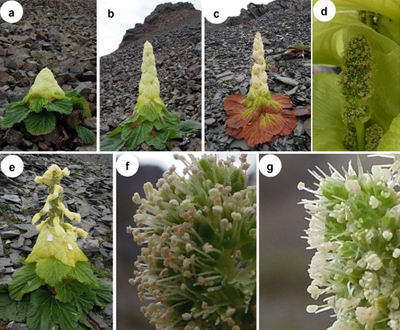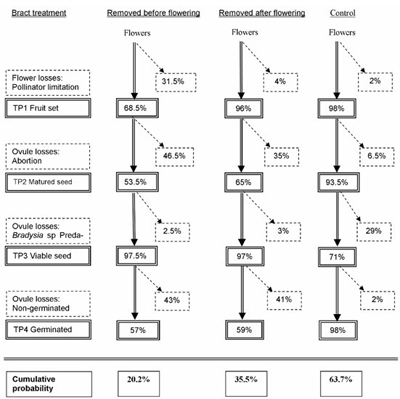Although alpine areas are generally characterized by low temperatures, high solar radiation, strong winds, cloudiness, frequent precipitation, low levels of insect abundance and activity and etc., it harbours high biodiversity. Thus, how these plants reproduce successfully in hostile environmental conditions is the topic of evolutionary biology. Plants in these areas frequently exhibit highly specialized structures to cope with the various stresses, for example, greenhouse and snowball plants. However, the specific evolutionary adaptive mechanisms of these specialized structures are still unclear.
Recently, Ph.D student SONG Bo and Prof. SUN Hang, from Kunming Institute of Botany, Chinese Academy of Sciences, investigated the evolutionary adaptive significances of large and showy bracts in Rheum nobile, a giant herb endemic to eastern high Himalayas. Bracts increased flower and fruit temperature on sunny days, greatly decreased the intensity of ultraviolet-B (UV-B) radiation reaching flowers and fruits, and prevented pollen grains being washed away by rain. Pollen germination experiments indicated that high temperature could promote pollen germination, while pollen grains exposed to rain and UV-B radiation at ambient levels were seriously damaged. Furthermore, bract removal decreased the number of pollinators visiting flowers. When bracts were removed before or after flowering, fecundity and progeny quality were adversely affected, but seed predation by larvae of pollinators decreased. A cost–benefit analysis demonstrated that the cost of bracts, i.e., increased seed predation, is modest. Based on these results, it is suggest that the bracts of R. nobile promote pollen germination, protect pollen grains from rain and intense UV-B radiation, enhance pollinator visitation during flowering, and facilitate the development of fertilized ovules during seed development. It is concluded that multifunctional bracts of R. nobile are an effective adaptive strategy in hostile alpine environments and might have been selected for because of abiotic environmental conditions as well as for enhancing pollination success.


Fig. 2 Flow chart of reproductive gains (solid lines) and losses (dotted lines) from flower to seed germination for Rheum nobile when bracts were either removed before or after flowering and compared to control plants. (Image by KIB)




